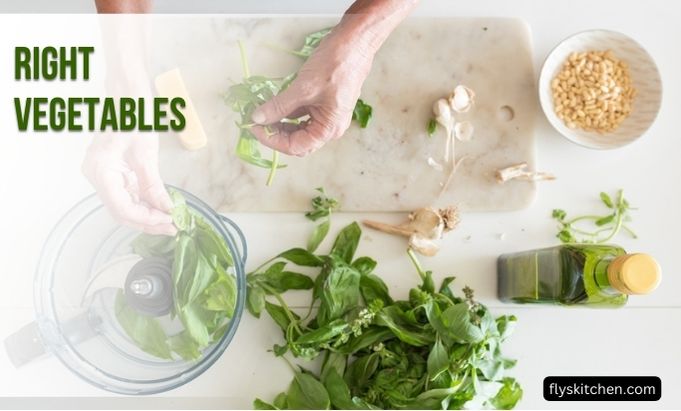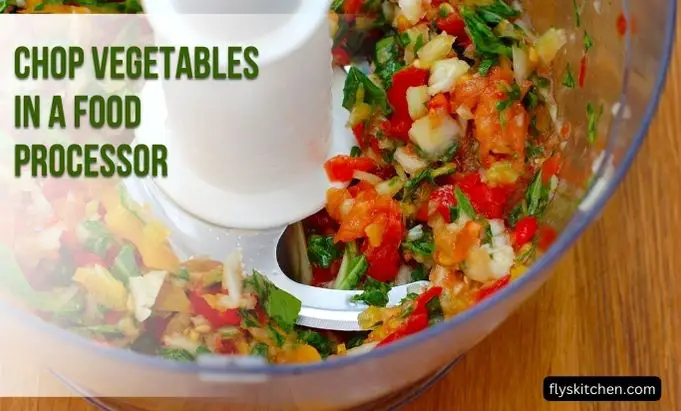Chopping vegetables by hand can be time consuming and tedious. Using a food processor makes prepping veggies a breeze, allowing you to get dinner on the table faster. This comprehensive guide will teach you how to chop vegetables in a food processor for quick, uniform pieces perfect for soups, stews, stir fries, casseroles, and more.
Contents
Introduction
Having chopped veggies ready to go is a game changer when it comes to whipping up meals during the busy work week. Once the prep work is done, dinner comes together in a snap. While knives certainly have their place in the kitchen, a food processor can chop in mere minutes which would take much longer by hand.
Food processors come with an array of blades and discs, but the standard chopping blade works wonders for most vegetables. With some simple tips, you’ll be chopping like a pro in no time. From selecting the right vegetables to achieving the perfect size, this article will cover everything you need to know. You’ll also find a handy table outlining prep and processing times for common vegetables.
Chopped veggies can be frozen for future use, so consider doubling recipes and storing half for later. Follow this guide for quick, easy vegetable chopping that will make your life easier.
Selecting the Right Vegetables

Virtually any vegetable can be processed, but some are better suited for chopping than others. Sturdy produce with a high water content tends to chop nicely. Good options include:
- Broccoli
- Carrots
- Cauliflower
- Celery
- Cucumbers
- Onions
- Peppers
- Potatoes
- Summer squash
- Sweet potatoes
- Tomatoes (canned or fresh)
Leafy greens like kale, chard and spinach are best processed in batches. Otherwise, they tend to fly around the bowl. For mushrooms, pulse a few times rather than continuously processing to get uniform pieces without turning them into mush.
Vegetables like eggplant and zucchini are very watery, so they may turn mushy if over-processed. Work in small amounts. The same goes for frozen vegetables, which release extra moisture.
Prep Tips
- Wash vegetables thoroughly and peel if desired. Trimming woody ends speeds up chopping.
- Cut vegetables into even 2-3 inch pieces so they process uniformly. Quarter onions, halved Brussels sprouts, etc.
- For carrots and celery, remove any fibrous strings for smoother chopping. Peel thicker-skinned vegetables like ginger.
- Pat wet vegetables dry before adding them to the processor. Excess moisture can hinder chopping.
How to Chop in a Food Processor?
- Cut vegetables into even-sized 2-3 inch chunks.
- Add vegetables to the processor bowl, being careful not to overfill. For most machines, filling above the half way point strains the motor. Process vegetables in batches for large recipes.
- Lock the lid in place, with the feed tube open. Make sure you’ve selected the chopping blade and it’s securely fastened.
- Pulse 5-10 times, allowing the blades to catch between pulses. Check for your desired size. Repeat 1-2 second pulses until the texture is right.
- For smoother chopping, let the processor run continuously for 5-10 seconds. Watch closely to avoid over-processing.
- To finely chop leafy greens, herbs or soft vegetables like tomatoes, start by pulsing once or twice. Then run the machine continuously for just a few seconds.
- Transfer the chopped vegetables to a bowl or storage container.
Aim for pieces around 1⁄4 to 1⁄2 inch in size for most recipes. Smaller chops work well for purees and soups. For stir fries and casseroles, 1⁄2 to 1 inch is preferable to allow the veggies to retain some texture.
Processing Times for Common Vegetables
| Vegetable | Prep | Total Time |
|---|---|---|
| Broccoli | Trim, cut into florets | 45 sec |
| Carrots | Peel, trim ends, quarter lengthwise or halve | 1 min |
| Cauliflower | Trim, cut into florets | 30 sec |
| Onions | Peel, quarter | 45 sec |
| Peppers | Core, seed, cut into chunks | 1 min |
| Potatoes | Peel (if desired) cut into 3” chunks | :45-1:00 |
| Summer Squash/Zucchini | Trim ends | :30-:45 secs |
| Tomatoes | Quarter or halve | :30-:45 secs |
Times are approximations and may vary by food processor model. Adjust processing time as needed to reach desired texture.
Cleaning Tips
- Rinse the bowl, lid and blade immediately after use to prevent staining.
- For dried on messes, fill the bowl with warm soapy water and let soak before scrubbing clean.
- The chopping blade sharp; handle carefully when cleaning.
- Some lids and bowls can go on the top rack of the dishwasher. Check your manual.
- Wipe the base of the processor clean with a damp cloth to keep it looking like new.
Storage Advice
Proper storage keeps chopped veggies fresh as long as possible. Here are a few guidelines:
- Allow vegetables to cool completely before packing up leftovers.
- Store in an airtight container or resealable plastic bag.
- Press out as much air as possible and ensure the container is sealed.
- Refrigerate for up to one week. Freeze for longer storage.
- Label leftovers with the date before freezing or refrigerating.
Chopping Vegetables for Freezer Storage
Chopping vegetables when you have spare time allows you to stock up for future meals. Follow these tips:
- Select fresh, in-season vegetables without blemishes.
- Steam briefly before chopping to retain color and nutrients.
- Spread pieces on a sheet pan and freeze until solid.
- Transfer frozen veggies to resealable bags. Squeeze out air and seal.
- Add frozen chopped veggies directly to soups, stews and casseroles.
- Store frozen chopped vegetables for 2-3 months.
FAQ
Still have questions about chopping vegetables in your food processor? Here are answers to some frequently asked questions:
What size should I chop vegetables for stir fries?
For stir fries, opt for 1⁄2 to 1 inch pieces so the vegetables retain some crispness when cooked quickly over high heat.
Should I peel vegetables before processing?
Peeling is optional for many vegetables like cucumbers and summer squash. For uniform chopping, peeling thicker skinned vegetables like carrots, sweet potatoes and ginger is recommended.
How do I prevent chopped onions from clumping up?
If onion pieces are sticking together, simply separate them with your fingers after processing. Next time, be sure onions are thoroughly dry before adding to the processor bowl.
Why do my leafy greens turn into a mushy mess?
Leafy greens contain a lot of moisture, so they quickly turn to mush. Process small batches using quick pulses rather than running the machine continuously.
Can I chop nuts in a food processor?
Yes, you can chop nuts in quick pulses. But take care not to over process them into nut butter or meal. Pulse just until the nuts are chopped to your desired size.
Conclusion
Chopping vegetables in a food processor is truly one of the handiest skills any home cook can master. Your prep time will be slashed, allowing you to get creative and prepare wholesome meals for your family. No more tedious chopping by hand or dragging out the old knife skills. Just toss vegetables in the processor and pulse your way to perfectly chopped produce in minutes. Keep this guide handy whenever inspiration for a new recipe strikes. Mastering this basic technique will transform the way you cook.

